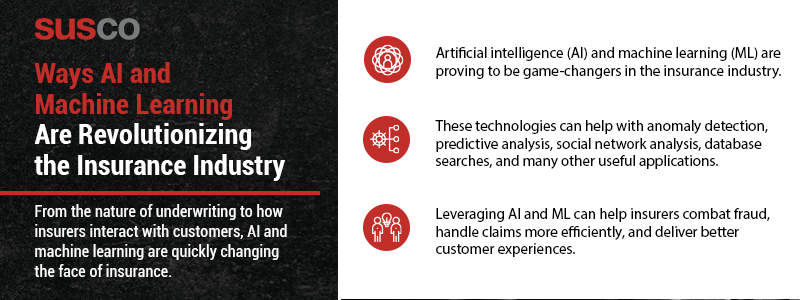From the nature of underwriting to how insurers interact with customers, AI and machine learning are quickly changing the face of insurance.

The insurance industry is experiencing a remarkable shift from traditional practices through the integration of AI and ML. These technologies are revolutionizing the insurance landscape, enabling companies to streamline processes, enhance customer experiences, mitigate risks, and make data-driven decisions like never before.
Here are four ways AI and ML are redefining the insurance industry:
1. Fraud detection and prevention
Fraud has long been a significant challenge in the insurance industry. The FBI estimates that the insurance industry loses over $40 billion to fraud each year, with the figure rising.
Recently, AI and ML have emerged as groundbreaking tools to combat fraud. These technologies are helping insurers manage claims more proactively through advanced fraud detection and prevention.
For example, ML algorithms can analyze large sets of data to find anomalies and fraud patterns in historical data, then use the data to identify potential fraud in future data. Insurers can also use the new data to train models to classify new examples of fraud.
Similarly, predictive analytics help insurers prevent fraud by identifying high-risk policyholders, customers, and locations ahead of time. They can then use this information to adjust deductibles and premiums or to deny coverage altogether.
Finally, AI is addressing the issue of identity theft through more secure authentication. Traditionally, insurers have had to rely on OTPs and passwords – which are susceptible to hacking. However, with AI-powered biometric authentication features such as face and fingerprint scanning and voice recognition integrated into their system, insurers can now confidently keep imposters at bay.
2. Underwriting
In underwriting, AI and ML streamline submission processing, provide more accurate risk assessments, and optimize rates for premiums.
Faster submission processing
Technologies like natural language processing (NLP) and optical character recognition (OCR) enable underwriters to extract information from unstructured data and process new submissions more efficiently. This reduces the labor, cost, and time involved in handling underwriting submissions.
Accurate risk assessment
Machine and deep learning models provide better risk assessment than manual underwriting as they rely on more diverse sources. With these models, insurers can quickly and accurately assess an applicant’s risk profile based on several data points, including location, IoT claims history, bank information, statistical data from public sources, social media platforms, and third parties.
Optimum and dynamic pricing
Getting prices right in the insurance industry is challenging – especially when using the traditional “cost-plus” method, which can’t quickly adapt to market fluctuations and doesn’t consider non-technical pricing factors.
However, with AI and ML integrated into the underwriting analysis, insurers have a broader range of data to pinpoint optimal pricing.
Moreover, the flexibility of these smart technologies makes it easy to align rates with changing market conditions and individual behaviors. For example, today’s dynamic models allow insurers to recalculate premiums and reprice algorithms after the fact, based on changing customer input and circumstances like goods transported or kilometers driven.
Claims processing and management will dramatically evolve in the next few years – and automation will be at the heart of it.
3. Claims processing and management
Per McKinsey research, AI and ML-powered automation will replace over half the current claims activities by 2030, resulting in faster and more accurate claims processing.
ML models will streamline the end-to-end technical adjudication of simple claims and reduce human judgment-based. Algorithms will handle claims routing and make data-driven decisions in critical areas like damage and coverage assessment, increasing claims processing efficiency.
On the other hand, humans will provide oversight of algorithmic decision-making, validating the output and intervening when factors exceed AI-defined thresholds. The role of claim handlers will shift to handling complex, unusual, and contested claims – such as those involving litigation or injury – and providing proactive support and advice to customers.
These professionals will continue to rely on their experience and judgment to make decisions. However, the analytical capabilities – like the ability to ingest and synthesize records, recognize patterns, detect fraud, and provide critical information – of AI and ML will enable them to make better decisions and resolve even the most complicated claims with increasing accuracy and speed.
4. Customer experience and engagement
In today’s digital era, customers have come to expect personalized services and seamless interaction from their insurance providers. However, with a sea of customers, vast reserves of data, and thousands of claims to process regularly, it can be difficult for insurers to reach out to customers with the right mix of products promptly.
In situations like these, AI and ML technologies are proving to be game changers, supporting the R&D process of data modeling and helping insurers deliver better customer experience through custom-fit services.
High-quality data and ML create a more seamless way of selling insurance by providing valuable insights such as individual customer behavior, when and how to communicate with them, their needs according to life stages, and their preferences.
Additionally, AI and ML are helping end users derive better satisfaction from their interaction with the insurer’s interface through automation.
For example, advisor bots and AI-powered service executives can offer quicker responses, reliable recommendations, consistent counseling, and post-sale services to customers – while humans handle complex tasks where they add the most value.
Incorporating the latest AI and ML technologies at the right points in the insurance workflow can yield many efficiencies and process improvements. It can help deter fraud, optimize underwriting and claims processing, and deliver outstanding customer satisfaction.
Curious about where to start?
Enhance your claims management with the latest AI and ML technologies
Susco can help you leverage AI and ML to modernize your claims management system. For over a decade, our experts have delivered custom solutions that close operational gaps, increase productivity, improve customer communication, and increase profitability.
Give your business a boost with Susco. Contact us today to learn more.